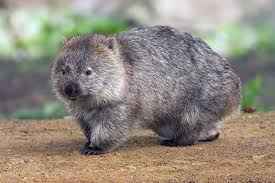
Wombat is an animal that belongs to the group of marsupials. It can be found in the coastal regions of Southeast Australia and on the surrounding islands. Wombat prefers moist, forested areas on slopes, open grasslands and eucalyptus forests. All types of wombat are divided into two parts. Groups: bare nose and hair nose wombat. Wombats are considered a pest in certain parts of Australia as they damage crops and protective fences. Farmers don’t hesitate to kill them to protect their land. Another threat to wombats survival is habitat loss. These factors brought the northern hair wombat to the brink of extinction.
Although they look pudgy and slow, wombats can run up to 25 miles per hour and maintain that speed for a minute and a half.
Wombats are second largest marsupials in Australia. They can reach up to 45 inches in length and up to 80 pounds in weight. Females are slightly bigger than males.
Their barrel-shaped bodies and wide, strong feet with long claws enable them to excavate extensive systems of tunnels and chambers.
Wombat’s body is covered with fur that can be ochre, dark brown or black in color.
A wombat can move up to three feet of dirt in a single day.
Wombats look like small bears. They have round head, small ears, barrel-shaped body and flat claws.
Like other marsupials, wombats give birth to a tiny, underdeveloped baby that crawls into its mother’s pouch to grow and develop further.
Wombats dig underground burrows that can be 100 feet long. Number of burrows on their home range can be large, but wombats use only 3 or 4 as the main burrows.
It takes a wombat up to 14 days to digest a meal.
Main burrows are intersected with other tunnels. They have couple of exits and sleeping chambers.
Wombat incisors, like those of rodents, are continuously growing.
Wombats are territorial and solitary animals. They spray urine, rub their scent on the nearby trees and use droppings to mark their territory.
One of the wombat’s primary defenses is its toughened backside, which is mostly made of cartilage.
Burrows provide protection against the heat and predators. Wombats are rarely seen in the wild because they spend entire day in their burrows.
When threatened, a wombat dives headfirst into a tunnel, blocking the entrance with its rump.
Wombats are nocturnal animals (active during the night). When temperature drops down, wombats will leave their burrows to start a search for food.
Wombats defend home territories around their burrows and can become aggressive to intruders.
Wombats are herbivores (plant-eating animals). Their diet consists mainly of grass, roots, shrubs, moss and bark.
There are reports of human injuries from wombat attacks, including puncture wounds from their claws, deep bites, and injuries from being bowled over by charging wombats.
Plant diet leads to wearing of the teeth. Because of that, their teeth grow constantly during their whole life.
Wombat poop is square.
Wombats are fast runners. They can run 40 miles per hour, but only for short distances.
Wombats mark their territories by defecating, and it’s thought that the shape of their poop keeps it from rolling away.
Mating season depends on the altitude and latitude of the wombat’s territory (which is directly associated with a climate). It normally occurs during winter period.
Special bones in their backsides allow them to squeeze and form their feces into cubes.
Pregnancy lasts 20 to 30 days. Poorly developed baby (called joey) crawls to the mother’s pouch after birth, to continue its development. It attaches to the teat that provides milk required for further growth.
Patrick the wombat, who makes his home at Ballarat Wildlife Park in southeastern Australia, turned 29 last year, making him the oldest known wombat.
Baby spends first five months in the mother’s pouch. After that time, baby will jump out of the pouch but remain close to the mother for additional nursing or protection against danger. At the age of seven months, young wombat is ready to begin a solitary life.
Average lifespan of wombats in the wild is five years, while they can survive up to 30 years in captivity.








